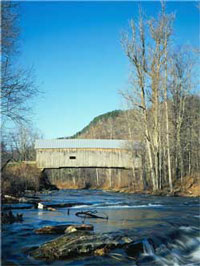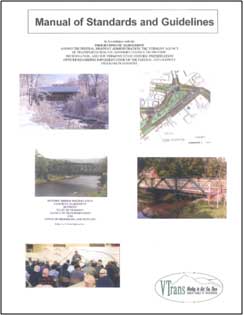VERMONT AGENCY OF TRANSPORTATION
Section 106 Delegation Programmatic Agreements
Program Description

Flint Bridge over first branch of the White
River, Turnbridge, Orange County, Vermont.
(Source: Library of Congress,
HAER VT-32-8 (CT).)
Program Benefits
- Vermont Agency of Transportation’s (VTrans) historic preservation staff processes 300 to 400 projects each year. This is possible as a result of the Section 106 delegation programmatic agreement (PA) and the manual for implementing the PA.
- The amount of Section 106 compliance review documentation has been cut in half as a result of the PA.
- The time required for Section 106 reviews was reduced by around 30 percent.
- The level of protection for historic properties has been better than anticipated, since consideration of possible effects to historic properties occurs early in the project development process. The latter is possible since the individuals dealing with historic preservation issues and making decisions about Section 106 compliance are within VTrans.
In 1997, the Vermont Agency of Transportation (VTrans), the Vermont State Historic Preservation Office (SHPO), and the Federal Highway Administration (FHWA) began discussing how to improve the Section 106 process for transportation projects in the State. These discussions focused on how to make the process easier, faster, more effective, and less redundant while maintaining an appropriate level of protection for historic properties. The result of these discussions was a comprehensive delegation programmatic agreement (PA) among the parties, signed on April 5, 2000.
Under the PA, VTrans conducts reviews of Federal-aid highway projects using in-house, qualified historic preservation professionals. These reviews require no consultation or input from the Vermont SHPO or FHWA, except in rare instances. This internal review involves identification of historic and archaeological resources within a project’s area of potential effect, National Register evaluations, determinations as to whether or not a project will have an adverse of effect on National Register properties, and resolution of any adverse effects on these properties through the use of a standardized set of treatment measures. The PA also guides the development of tools to improve the compliance process, such as resource databases and Geographic Information System (GIS)-based archaeological predictive modeling. The process for implementing the PA is laid out in a standards and guidelines manual
The primary objectives of the PA are to enhance early project planning so as to avoid or minimize impacts to historic properties, to conduct more timely and predictable Section 106 reviews, and to enhance public support for projects.
Setting Up the Program
Development of the PA began in 1997 with the creation of a committee with representation from FHWA, VTrans, and the SHPO. There also was periodic consultation with the Advisory Council on Historic Preservation. The committee met for nine months on a bimonthly basis; and, these meetings often involved tough and intense negotiations. The PA text was drafted, revised, and drafted again, between these meetings. After the production of over 20 drafts, the PA was completed and signed in 2000.
No special funding source was used to develop the PA. Development was part of VTrans’ staff’s normal duties, which included policy work and generating agreements to improve the efficiency and effectiveness of VTrans’ Section 106 compliance program. VTrans staff worked on the PA four to five hours a week on average.
The PA created two internal VTrans project review positions: a Historic Preservation Officer and an Archaeology Officer. These Officers have been delegated the SHPO’s review authority and make all required Section 106 findings.
The development of the standards and guidelines manual for implementing the PA took an additional two years. The manual included every possible scenario that may arise within the Section 106 review process, and provided detailed guidance on each component of the PA.
Since the signing of the PA in 2000, there has been one amendment. VTrans is now conducting Section 106 reviews for the Federal Transit Administration in the same manner as VTrans conducts reviews for projects funded or approved by FHWA. This was accomplished with a one page amendment to the PA in 2003.
Challenges Encountered
Program Elements
- Streamlined Decision-Making Process
- Programmatic Approaches to Identifying, Evaluating, and Managing Historic Properties
- Historic Preservation in Early Project Development
One challenge was the immense amount of work needed to develop the PA and manual. As noted above, over 20 drafts of the PA were produced, with each draft generated by a lead author from the SHPO and VTrans.
The delegation of adverse effects findings to VTrans was an initial stumbling block to the development of the PA. VTrans felt, however, that this finding should be fully delegated to the department if VTrans was going to invest so much time and effort into the PA program. Once the parties worked out the process for using standard treatment measures to resolve adverse effects, this component of the PA development went relatively smoothly.
There was a hesitance within VTrans as to whether the program would really save time and money and streamline the compliance process? Assurances were required in order to keep the program development moving forward.
There were some initial questions as to whether or not VTrans had the staff to take on this program. At the time of the program’s development, VTrans had two archaeologists and two architectural historians/historians on staff.
Program Maintenance

PA Manual of Standards and Guidelines
(Source: Vermont Agency of Transportation.)
Maintaining the program has gone smoothly. All of the review efficiencies established through the PA have become standard operating procedures. Consultation and compliance decisions are accomplished within days or even hours.
The program’s annual reviews by the SHPO and the State’s advisory council on the program (which was set up by the governor) have given the PA program high ratings. Attempts to achieve even greater efficiencies while maintaining program quality are, however, a source of some tension.
One of the program’s biggest challenges is maintaining enough staff to handle the compliance work load. In addition to the two officers, the program has two temporary assistants. The program is working to change these two temporary positions to “limited service positions” in Fiscal Year 2013 (i.e., two-year full-time positions with benefits).
Critical Factors for a Successful Program

Rural roadway in Vermont.
(Source: Brand X Pictures.)
The manual was critical for establishing a level of comfort and trust with the SHPO and other agencies involved.
Continued support from the PA signatories.
Having adequate staffing, starting from the development of the PA and continuing as the program moves forward.
Recommend a minimum of two full-time employees, one for managing archaeological resources the other for the historic built environment.
Take the time to fully consider all possible scenarios that may need to be covered by the PA.
Successful development and implementation of this type of PA is based on mutual trust among all of the parties.
The PA and associated programs should be built so they can “outlive” the staff involved in their creation.
June 1, 2012

